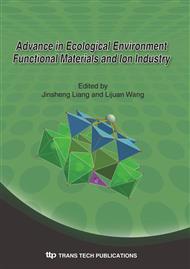p.201
p.207
p.215
p.221
p.227
p.233
p.237
p.241
p.245
Synthesis and Swelling Behaviors of Poly (sodium acrylate)/Hydroxyapatite Superabsorbent Nanocomposites
Abstract:
Superabsorbent nanocomposites based on partially neutralized acrylic acid (AA) and hydroxyapatite (HP) were prepared by free radical solution polymerization using N, N′-methylenebisacrylamide (MBA) as the crosslinker and ammonium persulfate (APS) as the initiator. The developed nanocomposites were characterized by Fourier-transform infrared spectroscopy (FTIR), scanning electron microscopy (SEM) and transmission electron microscopy (TEM). The effects of HP content on water absorbency of the nanocomposites were investigated, and the swelling behaviors of the nanocomposites in various pH solutions and their reswelling capability in distilled water were also systematically evaluated. FTIR spectra revealed that the P–OH groups of HP participated in graft polymerization reaction with AA. TEM analysis showed the needle-like crystals of HP present in the PAA/HP nanocomposite with a diameter of about 40 nm and a length of about 270 nm. The swelling rate and reswelling capability of the superabsorbents were improved due to the introduction of HP into PAA polymeric network, and this result implied that the nanocomposites acted as a recyclable water-saving material.
Info:
Periodical:
Pages:
227-232
Citation:
Online since:
January 2010
Authors:
Price:
Сopyright:
© 2010 Trans Tech Publications Ltd. All Rights Reserved
Share:
Citation:


